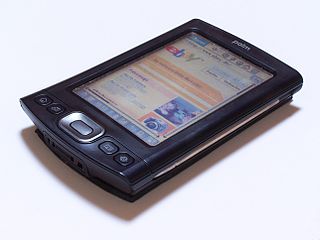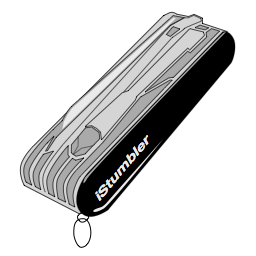Uses
The program was commonly used for:
- Verifying network configurations
- Finding locations with poor coverage in a WLAN
- Detecting causes of wireless interference
- Detecting unauthorized (rogue) access points
- Wardriving
| Developer(s) | 3Jacks Software |
|---|---|
| Stable release | 1.0.0 / January 2010 |
| Operating system | iOS, Palm OS |
| License | Commercial |
| Website | www |
WiFi-Where was a tool that facilitated Wardriving and detection of wireless LANs using the 802.11b, 802.11a and 802.11g WLAN standards. Versions existed for the operating systems iOS and Palm OS. Originally created in June 2004 for the Palm OS by Jonathan Hays of Hazelware Software, the IP for WiFi-Where was licensed to 3Jacks Software in 2009. An iPhone version of the application was released in January 2010, but was pulled from the App Store by Apple in March 2010. [1] The app was frequently listed as a common tool to facilitate Wardriving [2] As of 2010, it is still available in the Jailbroken Cydia store.[ citation needed ]
WiFi-Where was one of many applications that were suddenly purged by Apple in March 2010. Apple never commented publicly on the reasons why other than that they accessed 'private frameworks.' [3] [4] [5] This removal of an entire category of software from the App Store pushed Wardriving software to other platforms such as Android and Windows.
The program was commonly used for:
Some of the unique features that the program implemented were:

A personal digital assistant (PDA), also known as a handheld PC, is a multi-purpose mobile device which functions as a personal information manager. PDAs have been mostly displaced by the widespread adoption of highly capable smartphones, in particular those based on iOS and Android, and thus saw a rapid decline in use after 2007.

A wireless LAN (WLAN) is a wireless computer network that links two or more devices using wireless communication to form a local area network (LAN) within a limited area such as a home, school, computer laboratory, campus, or office building. This gives users the ability to move around within the area and remain connected to the network. Through a gateway, a WLAN can also provide a connection to the wider Internet.

Wi-Fi is a family of wireless network protocols based on the IEEE 802.11 family of standards, which are commonly used for local area networking of devices and Internet access, allowing nearby digital devices to exchange data by radio waves. These are the most widely used computer networks, used globally in home and small office networks to link devices and to provide Internet access with wireless routers and wireless access points in public places such as coffee shops, hotels, libraries, and airports to provide visitors.

Wardriving is the act of searching for Wi-Fi wireless networks as well as cell towers, usually from a moving vehicle, using a laptop or smartphone. Software for wardriving is freely available on the internet.

A hotspot is a physical location where people can obtain Internet access, typically using Wi-Fi technology, via a wireless local-area network (WLAN) using a router connected to an Internet service provider.

iStumbler is a utility for finding wireless networks and devices with AirPort or Bluetooth-enabled Macintosh computers.
NetStumbler was a tool for Windows that facilitates detection of Wireless LANs using the 802.11b, 802.11a and 802.11g WLAN standards. It runs on Microsoft Windows operating systems from Windows 2000 to Windows XP. A trimmed-down version called MiniStumbler is available for the handheld Windows CE operating system.

Wireless security is the prevention of unauthorized access or damage to computers or data using wireless networks, which include Wi-Fi networks. The term may also refer to the protection of the wireless network itself from adversaries seeking to damage the confidentiality, integrity, or availability of the network. The most common type is Wi-Fi security, which includes Wired Equivalent Privacy (WEP) and Wi-Fi Protected Access (WPA). WEP is an old IEEE 802.11 standard from 1997. It is a notoriously weak security standard: the password it uses can often be cracked in a few minutes with a basic laptop computer and widely available software tools. WEP was superseded in 2003 by WPA, a quick alternative at the time to improve security over WEP. The current standard is WPA2; some hardware cannot support WPA2 without firmware upgrade or replacement. WPA2 uses an encryption device that encrypts the network with a 256-bit key; the longer key length improves security over WEP. Enterprises often enforce security using a certificate-based system to authenticate the connecting device, following the standard 802.11X.
IEEE 802.11u-2011 is an amendment to the IEEE 802.11-2007 standard to add features that improve interworking with external networks.
Wi-Fi calling refers to mobile phone voice calls and data that are made over IP networks using Wi-Fi, instead of the cell towers provided by cellular networks. Using this feature, compatible handsets are able to route regular cellular calls through a wireless LAN (Wi-Fi) network with broadband Internet, while seamlessly change connections between the two where necessary. This feature makes use of the Generic Access Network (GAN) protocol, also known as Unlicensed Mobile Access (UMA).
A wireless site survey, sometimes called an RF site survey or wireless survey, is the process of planning and designing a wireless network, to provide a wireless solution that will deliver the required wireless coverage, data rates, network capacity, roaming capability and quality of service (QoS). The survey usually involves a site visit to test for RF interference, and to identify optimum installation locations for access points. This requires analysis of building floor plans, inspection of the facility, and use of site survey tools. Interviews with IT management and the end users of the wireless network are also important to determine the design parameters for the wireless network.
In computing, a wireless intrusion prevention system (WIPS) is a network device that monitors the radio spectrum for the presence of unauthorized access points (intrusion detection), and can automatically take countermeasures (intrusion prevention).

Eye-Fi was a company based in Mountain View, California, that produced SD memory cards with Wi-Fi capabilities. Using an Eye-Fi card inside a digital camera, one could wirelessly and automatically upload digital photos to a local computer or a mobile device such as a smartphone or tablet computer. The company ceased business in 2016.
Network detectors or network discovery software are computer programs that facilitate detection of wireless LANs using the 802.11b, 802.11a and 802.11g WLAN standards. Discovering networks may be done through active as well as passive scanning.

WiGLE is a website for collecting information about the different wireless hotspots around the world. Users can register on the website and upload hotspot data like GPS coordinates, SSID, MAC address and the encryption type used on the hotspots discovered. In addition, cell tower data is uploaded and displayed.
SoftAP is an abbreviated term for "software enabled access point". Such access points utilize software to enable a computer which hasn't been specifically made to be a router into a wireless access point. It is often used interchangeably with the term "virtual router".

Meru Networks was a supplier of wireless local area networks (WLANs) to healthcare, enterprise, hospitality, K-12 education, higher education, and other markets. Founded in 2002 and headquartered in Sunnyvale, California, United States, the company made its initial public offering in March 2010, and was acquired by Fortinet in May 2015.
NetSpot is a software tool for wireless network assessment, scanning, and surveys, analyzing Wi-Fi coverage and performance. It runs on Mac OS X 10.6+ and Windows 7, 8 and 10. Netspot supports 802.11n, 802.11a, 802.11b, and 802.11g wireless networks and uses the standard Wi-Fi network adapter and its Airport interface to map radio signal strength and other wireless network parameters, and build reports on that. NetSpot was released in August 2011.

WiFi Explorer is a wireless network scanner tool for macOS that can help users identify channel conflicts, overlapping and network configuration issues that may be affecting the connectivity and performance of Wi-Fi networks.

The iPad Mini 2 is a tablet computer produced and marketed by Apple Inc. It has a nearly identical design to its predecessor, the first-generation iPad Mini, but features internal revisions such as the use of an A7 system-on-a-chip and a 2,048 x 1,536 resolution Retina Display. Internally, the second-generation iPad Mini has nearly the same hardware as its sibling device, the iPad Air. Apple released the second-generation iPad Mini in space gray and silver colors on November 12, 2013.